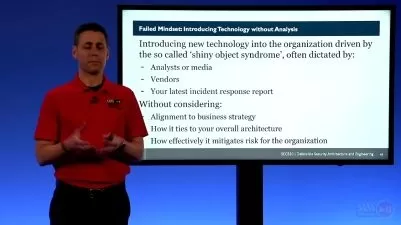Nagios | Ultimate IT monitoring guide with EyesOfNetwork
Tech Academy
10:31:05
Description
The complete guide for IT supervision with EyesOfNetwork bundle (Nagios/Nagvis/Nagiosbp/...)
What You'll Learn?
- Install the EyesOfNetwork solution with centOS operating system
- Master the best monitoring software in the market (Nagios, Nagvis, NagiosBP, NSClient++,...etc)
- Build virtually the IT infrastructure to monitor
- Model any IT infrastructure as a MAP
- Dashboard customization
- Be able to monitor any IT object (OS/Database/Router/Application servers,...etc)
- Monitor operating systems (Windows/Ubuntu: CPU, Disks, Memory, Network, users,... etc)
- Monitor Oracle database objects (connection time, tablespaces, passwords expiration,... etc)
- Issues troubleshooting
- Monitor application servers (Tomcat: Memory, threads, service, homepage,..etc)
- Nagios resources and Macros list
- Understand and use Nagios business processes
- Adapt and fix monitoring plugins
- Create your own monitoring scripts
- SNMP checks
- Understand and use NRPE
- Establish secured NRPE (with TLS, with client authentication)
- Handle NRPE clients (NSClient++, JNRPE, Nagios agent)
- Master the Nagvis module
- Setup the mail notification
- Users/Roles management in EyesOfNetwork
- Get by the end a complete autonomous and reusable monitoring solution
Who is this for?
What You Need to Know?
More details
DescriptionWelcome to my course on EyesOfNetwork.
EyesOfNetwork is Nagios based solution made up of a set of Open Source software that meet the needs of the big crescents for the supervision of Business Information Systems.
This course will teach you, step by step, how to install and setup the EyesOfNetwork solution then how to use its main modules.
We will build virtually our proper IT infrastructure to monitor in this course so we can cover the monitoring of all IT objects widely used in real life information systems.
This is a Learn by example course, by following its lectures you will build a complete autonomous supervision system including a dashboard from which you can keep an eyes on all your IT platform from a single place.
The troubleshooting lectures are bringing the fix for the most common issues that you can face when putting such solution in place.
In this course, you will:
Install EyesOfNetwork with CentOS from ISO.
EyesOfNetwork solution setup and overview.
Build the IT infra to monitor: Windows 10 host, Ubuntu host, Oracle database, Tomcat server, Java Virtual Machine, Docker,.. etc
How to use NRPE
Install and configure NRPE clients: NSClient++, JNRPE, Nagios agent
Windows related objects monitoring
Tomcat related objects monitoring
JVM related objects monitoring
TLS certificates monitoring
Oracle database related objects monitoring
Remote shared drive monitoring
Ubuntu related objects monitoring
Docker containers monitoring
Design a map with Microsoft Visio
Create and setup maps on Nagvis
Configure mail notification on EyesOfNetwork
Users/Roles management
And much more
Enroll in this course now and become a monitoring pro.
Who this course is for:
- People who want to learn how to monitor an IT infrastructure
- IT engineers and integrators who are motivated to boost their career
- Business owners who need to get a ready to use monitoring solution to keep an eye on their information system
Welcome to my course on EyesOfNetwork.
EyesOfNetwork is Nagios based solution made up of a set of Open Source software that meet the needs of the big crescents for the supervision of Business Information Systems.
This course will teach you, step by step, how to install and setup the EyesOfNetwork solution then how to use its main modules.
We will build virtually our proper IT infrastructure to monitor in this course so we can cover the monitoring of all IT objects widely used in real life information systems.
This is a Learn by example course, by following its lectures you will build a complete autonomous supervision system including a dashboard from which you can keep an eyes on all your IT platform from a single place.
The troubleshooting lectures are bringing the fix for the most common issues that you can face when putting such solution in place.
In this course, you will:
Install EyesOfNetwork with CentOS from ISO.
EyesOfNetwork solution setup and overview.
Build the IT infra to monitor: Windows 10 host, Ubuntu host, Oracle database, Tomcat server, Java Virtual Machine, Docker,.. etc
How to use NRPE
Install and configure NRPE clients: NSClient++, JNRPE, Nagios agent
Windows related objects monitoring
Tomcat related objects monitoring
JVM related objects monitoring
TLS certificates monitoring
Oracle database related objects monitoring
Remote shared drive monitoring
Ubuntu related objects monitoring
Docker containers monitoring
Design a map with Microsoft Visio
Create and setup maps on Nagvis
Configure mail notification on EyesOfNetwork
Users/Roles management
And much more
Enroll in this course now and become a monitoring pro.
Who this course is for:
- People who want to learn how to monitor an IT infrastructure
- IT engineers and integrators who are motivated to boost their career
- Business owners who need to get a ready to use monitoring solution to keep an eye on their information system
User Reviews
Rating
Tech Academy
Instructor's Courses
Udemy
View courses Udemy- language english
- Training sessions 141
- duration 10:31:05
- English subtitles has
- Release Date 2024/02/14














